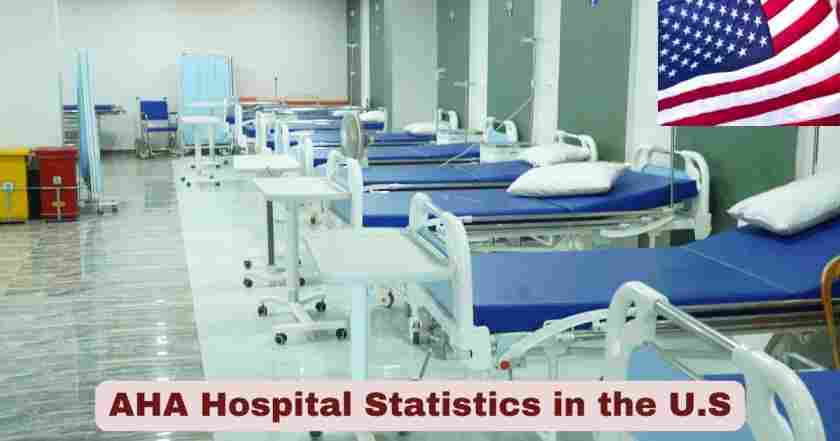AHA Hospital in the U.S. in 2025
The American Hospital Association (AHA) continues to serve as the definitive source for comprehensive hospital statistics across the United States, representing a vast network of 6,093 hospitals that form the backbone of America’s healthcare system. As the nation’s leading advocate for hospitals and health systems, the AHA conducts the most extensive annual survey of hospitals in the country, collecting data from over 6,200 hospitals and 400 health systems to provide unparalleled insights into hospital operations, utilization, and financial performance. This comprehensive data collection effort, featuring over 1,300 hospital data points, enables healthcare leaders, policymakers, and researchers to understand the evolving landscape of American healthcare delivery.
The significance of AHA hospital statistics extends far beyond mere numbers, as these data points directly impact healthcare policy decisions, resource allocation, and strategic planning for millions of Americans seeking medical care. With hospital expenses reaching unprecedented levels and healthcare utilization patterns shifting dramatically, the AHA’s 2025 statistics reveal critical trends that influence everything from hospital bed availability to staffing levels and financial sustainability. The organization’s commitment to transparency through publicly available fast facts and detailed statistical reports ensures that stakeholders across the healthcare ecosystem have access to the most current and reliable information about America’s hospital infrastructure.
Facts About AHA Hospital in the U.S. 2025
| Key Hospital Facts | 2025 Statistics | Significance |
|---|---|---|
| Total U.S. Hospitals | 6,093 hospitals | Comprehensive nationwide coverage |
| Data Sources | Over 6,200 hospitals surveyed | Exceptional response rate and accuracy |
| Health Systems | 400 health systems | Major consolidation trend |
| Data Points Collected | Over 1,300 metrics | Most comprehensive hospital database |
| Survey History | Annual surveys since 1946 | Nearly 80 years of trend data |
| Response Rate | 83% average over 5 years | High reliability and representativeness |
| Community Hospitals | 5,112 hospitals | Primary healthcare delivery network |
| Publication Timeline | 2025 edition from 2023 survey | Most current available data |
The American Hospital Association’s statistical prowess represents the gold standard in healthcare data collection, with an impressive 83% response rate maintained consistently over the past five years. This exceptional participation level ensures that the 6,093 hospitals captured in the 2025 statistics truly represent the diverse landscape of American healthcare delivery. The organization’s commitment to collecting over 1,300 data points annually from each participating facility creates an unmatched repository of hospital performance metrics that spans nearly eight decades of healthcare evolution.
The breadth and depth of AHA’s data collection efforts become even more impressive when considering that information is gathered from both individual hospitals and 400 health systems nationwide. This dual approach captures the increasing trend toward hospital consolidation while maintaining granular insights into individual facility performance. The 5,112 community hospitals that form the core of America’s healthcare safety net are particularly well-represented in these statistics, ensuring that policy decisions and resource allocation strategies are based on comprehensive, real-world data rather than estimates or projections.
Hospital Infrastructure and Capacity in the U.S. 2025
| Infrastructure Metrics | 2025 Numbers | Operational Impact |
|---|---|---|
| Total Staffed Beds | 913,136 beds | National capacity benchmark |
| Community Hospital Beds | 781,148 beds | Primary care capacity |
| Total Annual Admissions | 34,426,650 admissions | Healthcare utilization volume |
| Community Hospital Admissions | 32,345,846 admissions | Core healthcare demand |
| Rural Community Hospitals | 1,796 hospitals | Rural healthcare access |
| Urban Community Hospitals | 3,316 hospitals | Metropolitan healthcare hub |
| Hospital System Affiliations | 3,525 hospitals | Consolidation trend indicator |
| Bed Utilization Analysis | Varies by region | Capacity planning metric |
The scale of America’s hospital infrastructure becomes evident through the 913,136 staffed beds available across all hospital types, representing a massive investment in healthcare capacity that serves over 34.4 million admissions annually. The 781,148 community hospital beds account for the vast majority of this capacity, highlighting the central role that community hospitals play in everyday healthcare delivery. These facilities handle approximately 32.3 million admissions each year, demonstrating the critical importance of maintaining adequate bed capacity to meet national healthcare demand.
The geographic distribution of hospital infrastructure reveals significant patterns in healthcare access, with 3,316 urban community hospitals serving densely populated metropolitan areas while 1,796 rural community hospitals provide essential healthcare services to America’s rural communities. This distribution pattern reflects both population density and the unique challenges of maintaining healthcare access in less populated areas. The fact that 3,525 hospitals are now affiliated with health systems indicates a continuing trend toward consolidation, which has important implications for healthcare delivery models, pricing, and service coordination across different facilities.
Hospital Ownership and Governance in the U.S. 2025
| Ownership Categories | Number of Hospitals | Market Share |
|---|---|---|
| Nongovernment Not-for-Profit | 2,978 hospitals | 48.9% of total |
| Investor-Owned For-Profit | 1,214 hospitals | 19.9% of total |
| State and Local Government | 920 hospitals | 15.1% of total |
| Federal Government | 207 hospitals | 3.4% of total |
| Nonfederal Psychiatric | 654 hospitals | 10.7% of total |
| Other Specialty Hospitals | 120 hospitals | 2.0% of total |
| Community Hospital Total | 5,112 hospitals | 83.9% of total |
| System-Affiliated Hospitals | 3,525 hospitals | 57.9% of total |
The ownership landscape of American hospitals reveals a predominantly not-for-profit sector, with 2,978 nongovernment not-for-profit hospitals comprising nearly half of all hospital facilities in the United States. This substantial presence of charitable and religious organizations in healthcare delivery reflects the historical development of American hospitals and continues to play a crucial role in providing care to underserved populations. The 1,214 investor-owned for-profit hospitals represent a significant and growing segment of the market, bringing business efficiency models to healthcare delivery while raising important questions about the balance between profit motives and patient care.
Government-operated hospitals, including 920 state and local government facilities and 207 federal government hospitals, serve as crucial safety net providers for vulnerable populations and specialized care needs. The 654 nonfederal psychiatric hospitals highlight the specialized nature of mental health care delivery, while 120 other specialty hospitals address specific medical needs ranging from rehabilitation to long-term acute care. The dominance of 5,112 community hospitals within the overall hospital ecosystem demonstrates their fundamental importance in American healthcare, while the 3,525 hospitals affiliated with health systems indicate the ongoing trend toward integrated healthcare delivery models.
Hospital Financial Performance in the U.S. 2025
Financial Performance Metrics
| Financial Indicator | 2024 Performance | 2025 Projections | Regional Variation |
|---|---|---|---|
| Median Operating Margin | 4.9% | 1% – 2% | Varies by region |
| Inpatient Revenue Growth | – | 7.4% | Northeast: 9.8%, Midwest: 8.2%, South: 6.8%, West: 6.3% |
| Outpatient Revenue Growth | – | 4.4% | Across all regions |
| Non-labor Expense per Discharge | – | +2.3% | National average |
| Labor Expense per Discharge | – | +1.2% | National average |
| Total Expense per Discharge | – | +1.6% | National average |
| Hospitals with 6%+ Margin | 40% (2023) | 60% (projected) | Nonprofit hospitals |
Hospital financial performance in 2025 demonstrates a paradoxical situation where strong revenue growth coincides with margin compression. The robust inpatient revenue surge of 7.4 percentage points reflects increased patient volumes and higher reimbursement rates, while outpatient services contribute a solid 4.4 percentage points growth. Regional disparities are evident, with Northeast hospitals leading at 9.8 percentage points growth, suggesting varying market conditions and payer mix advantages. Despite this impressive revenue performance, the projected decline in median operating margins from 4.9% in 2024 to just 1-2% in 2025 indicates that hospitals are facing significant cost pressures that are eroding profitability.
The expense management challenge is multifaceted, with non-labor expenses rising 2.3% per adjusted discharge, outpacing labor expense growth of 1.2%. This suggests that hospitals are dealing with inflation in medical supplies, pharmaceuticals, and technology costs while maintaining better control over personnel expenses. The long-term outlook shows promise, with 60% of nonprofit hospitals expected to achieve operating margins of 6% or higher by 2025, up from 40% in 2023. This improvement indicates that hospitals are implementing strategic cost reduction initiatives and operational efficiencies that should restore financial stability once the current inflationary pressures subside.
Hospital Workforce and Staffing in the U.S. 2025
Workforce Staffing Statistics
| Workforce Category | Current Numbers | Growth Rate (2019-2023) | Projected Shortage | Future Outlook |
|---|---|---|---|---|
| Total Nursing Workforce | 4,140,550 (2023) | +4.6% | 250,000-400,000 by 2025 | Critical shortage |
| Nurse Practitioners | – | +35.5% | – | Strong growth |
| Licensed Practical/Vocational Nurses | – | -8.4% | – | Declining trend |
| Total Healthcare Workers | – | – | 3.2 million by 2026 | Severe shortage |
| Projected New Healthcare Jobs | – | – | 19 million by 2030 | Massive expansion |
The hospital workforce landscape reveals a complex scenario of growth and shortage that threatens operational sustainability. The nursing workforce, totaling 4.14 million professionals in 2023, has experienced modest growth of 4.6% since 2019, yet this expansion is insufficient to meet growing demand. The projected shortage of 250,000 to 400,000 nurses by 2025 represents a critical threat to patient care quality and hospital operational capacity. This shortage is compounded by structural changes within nursing roles, where nurse practitioners have surged by 35.5% between 2019 and 2023, indicating a shift toward advanced practice roles, while licensed practical and vocational nurses have declined by 8.4%, suggesting automation and role consolidation in basic nursing functions.
The broader healthcare workforce crisis extends well beyond nursing, with projections indicating a staggering shortage of 3.2 million healthcare workers by 2026. This shortage occurs despite ambitious job creation projections of 19 million new healthcare positions by 2030, highlighting a fundamental mismatch between workforce supply and healthcare demand. The implications for hospitals are profound, as they must compete aggressively for limited talent while potentially compromising staffing ratios and service levels. This workforce shortage directly impacts hospital finances through increased recruitment costs, higher compensation packages, and potential revenue losses from reduced capacity to serve patients effectively.
Technology and Innovation in Hospital Operations in the U.S. 2025
Technology Implementation Status
| Technology Category | Implementation Level | Current Status | Innovation Impact |
|---|---|---|---|
| Electronic Health Records | Near-universal (95%+) | Standard practice | Care coordination improvement |
| Telehealth Capabilities | Rapid expansion | Post-pandemic growth | Access enhancement |
| Artificial Intelligence | Emerging implementation | Selective deployment | Diagnostic assistance |
| Robotic Surgery Systems | Limited deployment | Specialty-specific | Precision improvement |
| Digital Imaging | Standard practice | Universal adoption | Diagnostic accuracy |
| Patient Monitoring Systems | Advanced deployment | Safety-focused | Early intervention |
| Data Analytics | Growing utilization | Performance optimization | Operational efficiency |
| Cybersecurity Measures | Critical infrastructure | Mandatory implementation | Information protection |
Technology adoption in American hospitals has reached unprecedented levels, with electronic health records achieving near-universal implementation across the nation’s 6,093 hospitals. This digital transformation has fundamentally altered care delivery, enabling seamless information sharing between providers and reducing medical errors through automated alerts and decision support systems. Telehealth capabilities have expanded exponentially, particularly following the COVID-19 pandemic, allowing hospitals to extend their reach beyond traditional facility boundaries and provide remote monitoring services that improve patient outcomes while reducing costs.
Emerging technologies such as artificial intelligence and robotic surgery systems represent the next frontier in hospital innovation, though implementation remains selective based on specialty needs and financial capabilities. Digital imaging has become standard practice across hospital radiology departments, while advanced patient monitoring systems enhance patient safety through continuous surveillance and early warning systems. The increasing reliance on technology necessitates robust cybersecurity measures to protect patient information and maintain operational continuity, making information technology infrastructure a critical component of modern hospital operations that requires ongoing investment and expertise.
Quality Metrics and Patient Safety in the U.S. 2025
Patient Safety Performance Indicators
| Quality Metric | Performance Target | Current Trend | Safety Impact |
|---|---|---|---|
| Hospital-Acquired Infections | Continuous reduction | Declining rates | Patient safety priority |
| Medication Error Rates | Zero tolerance goal | Quality improvement focus | Safety system enhancement |
| Patient Satisfaction Scores | 90%+ target | Experience measurement | Care quality indicator |
| 30-Day Readmission Rates | <15% target | Quality efficiency metric | Outcome improvement |
| Risk-Adjusted Mortality Rates | Benchmarked outcomes | Clinical effectiveness | Life-saving impact |
| Average Length of Stay | Efficiency optimization | Resource utilization | Cost management |
| Accreditation Compliance | 100% requirement | Quality certification | Standards compliance |
| Safety Event Reporting | Complete transparency | Continuous improvement | Preventive measures |
Quality metrics and patient safety indicators serve as fundamental measures of hospital performance, with hospital-acquired infection rates representing one of the most critical safety benchmarks. These infections, which can significantly extend hospital stays and increase healthcare costs, have become a primary focus for targeted reduction efforts through enhanced sanitation protocols, antibiotic stewardship programs, and infection control measures. Medication error rates reflect the effectiveness of comprehensive safety systems designed to prevent harmful drug interactions and dosing mistakes, with hospitals implementing sophisticated electronic prescribing systems and clinical decision support tools to minimize human error and improve patient outcomes.
Patient satisfaction scores provide valuable insights into the overall care experience, measuring not only clinical outcomes but also communication effectiveness, responsiveness to patient needs, and coordination of care services. Readmission rates serve as both quality and efficiency metrics, indicating whether patients receive appropriate care during their initial hospitalization and adequate discharge planning to prevent unnecessary returns within 30 days. These quality indicators collectively help hospitals identify areas for improvement while providing transparency to patients, families, and regulatory bodies about institutional performance standards and patient safety commitments, ultimately driving continuous improvement in care delivery and patient outcomes.
Disclaimer: The data research report we present here is based on information found from various sources. We are not liable for any financial loss, errors, or damages of any kind that may result from the use of the information herein. We acknowledge that though we try to report accurately, we cannot verify the absolute facts of everything that has been represented.







